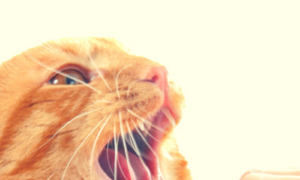By Elizabeth Wasserman for The Daily Cat

Certified cat behavioral consultant Marilyn Krieger recently received a flustered phone call from a couple in Redwood City, Calif: One of the couple’s two cats had started spraying urine around the perimeter doors and windows of their home. The two cats had always lived together peacefully. The owners were wondering what was provoking the cat marking behavior.
After visiting the family, Krieger learned that the couple had recently started feeding stray feral cats right outside their home. They said the male cat would get very upset when the feral cats arrived. He could see them out the window. “Cats spray for a variety of reasons,” Krieger says. “In this case, it could be a way of telling the world and the other outside cats, ‘Hey, I’m here. Stay out. This is where I live. You don’t belong here.’”
Cats use a variety of methods to mark people, things and territory with their scent. Spraying and scratching are two such scent-marking ways that are the most difficult for pet owners to tolerate. In contrast, other feline marking behaviors are endearing. For example, cats engage in head-“bunting” — butting a person with the head — or rubbing up against someone’s hand with their cheeks to release scents that mark you as their loved ones.
Glands and Plans
Cats have glands on certain parts of the body that explain many of these marking behaviors. These glands can secrete a subtle scent emanating from chemicals that scientists call pheromones. Pheromones are essential to cat communication. They allow felines to attract mates, define territories, promote a sense of comfort and let other cats know who and where they are. “It’s like leaving a calling card,” says Pamela Johnson-Bennett, a certified animal behavior consultant (CABC).
Cats secrete the pheromones from glands located in a variety of locations on their bodies. Here’s a guide to the locations and how those explain certain cat behaviors:
- Forehead and cheeks The scent glands located on the forehead and cheeks are often used to promote calming behaviors that we see as very loving and friendly. Such behaviors may include head-bunting and cheek-rubbing.
- Paw bottoms When your cat scratches, be it on the arm of a sofa or on a scratching post, it is not only leaving a physical mark, but also an olfactory one. “They’re not scratching only to give themselves a manicure,” says Krieger. “They are marking as well.”
- In the urine stream Cat urine contains pheromones too. Urine spraying by cats should not be confused with urination. Spraying is done on walls, windows, furniture and other objects. After a cat sniffs the target, it turns around, lifts its tail, and sprays urine at the target.
Why They Do It
Different types of marking behaviors are often prompted by very different motivations on the part of our furry friends. Johnson-Bennett, also author of the book Starting from Scratch (Penguin 2007), has a general rule of thumb: the markings from the front of the cat are most often “friendly” behaviors, while the scent markings coming from the rear are often “unfriendly.” Here is what your cat may be trying to communicate:
- Marking you — or another pet — as “Mine!” When cats head-bunt or rub cheeks on humans, it is often to mark you as their own. They will also mark a fellow feline this way. “Pheromone is a scent chemical, but it also helps cats with bonding behavior,” Johnson-Bennett says. “If two cats know each other and are friendly, they will engage in scent exchange. It helps the colony to have one familiar scent.”
- Communicate that they live there Scratching is a natural feline impulse and activity. Cats do this whether they are indoors or outdoors. They pick a few different objects to scratch — trees, chair legs, scratching posts — and return often. It is one method of communicating that they live there. Scratching in a new location may be prompted by change, including a move or the purchase of new furniture. Cats are comforted when surrounded by their own scent in a room, such as on a couch or on the carpet.
- Telling others to “Keep out!” Spraying is often used to mark territory or to communicate boundaries. It may often be prompted indoors by a change in environment, such as moving to a new home, buying new furnishings and remodeling. Or it may be a reaction to a new member of the household, be it a baby, a new husband or a new pet. Cat urine, which can be quite pungent, may be directed at draperies, walls, furnishings and more.
Keep a Positive Spin on Marking
Since marking is a natural feline behavior, remember that you can take steps to keep your pet’s instincts positive. Here are five tips from cat behaviorists on how to channel your cat’s marking:
- Rub your cat’s cheeks and head. This has a very calming and reassuring effect on your cat, Johnson-Bennett says
- Rub those “friendly” glands on the head and cheeks with a dry wash cloth and spread the scent on new furnishings. This could help to deter scratching behavior, according to Johnson-Bennett
- Offer your pet places to scratch, such as stable vertical scratching posts and horizontal posts as well. Never buy these used because they may carry the markings of another cat and prompt your pet to spray, Krieger says
- Prepare your pet for change. If a new baby is expected, invite someone over with an infant to accustom your cat to the noise, scent and presence of a baby
- If your cat has sprayed in certain areas, wash those with an enzyme-based cleaner that removes the odor, Krieger suggests. Even if you address the underlying cause that prompted the spraying, your cat may return to spray in an area if it still detects its own scent
Krieger, whose business is called The Cat Coach, recommended to her clients that they not only clean, but that they also address the root cause of their male cat’s spraying. She advised them to block the windows and feed the feral cats away from their home. She advises, “You have to make sure you remove the trigger.”
Elizabeth Wasserman, a Washington, D.C., area-based freelancer, has been writing about pets, among other topics, for more than 15 years. Her love of dogs, in particular, was handed down through the generations from her great-grandfather, Eric Knight, who wrote the book Lassie Come Home in the 1930s.





